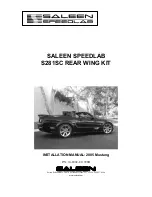
78
8. Seal the windows from outside with light-tight paper (cloth) or shut with shields.
9. Remove the wheels from the vehicle, clean the wheel rims of dirt and touch up the damaged areas. Clean the tires
of dirt, wash and dry them and bring the pressure to normal level.
10.
If necessary, flush out the fuel tanks and fill them with fuel.
11.
Prepare the battery for storage according to the service and operation guidelines for automotive lead starter
batteries.
12.
Cover the air filter inlet tube and the muffler tailpipe with oiled paper.
13.
Loosen the belt tension of fan, alternator and water pump drive.
14. Drain the liquid from the cooling system, heater radiator, and windshield washer reservoir.
15.
Seal the gearbox housings, transfer case housings, front and rear axles by wrapping their safety valves in
insulating tape.
16.
Seal the gap between the brake pads and the drums with oiled paper.
17.
Keep the tires and other rubber parts from direct sunlight.
18.
Put metal or wooden props under the axles so that the wheels are raised above the floor or the ground.
Release the bow and springs by putting wooden spacers between the frame and the axles.
The preserved vehicle should be located in a clean ventilated room with a relative humidity of 40
–
70% and
temperature not less than +
5 °C.
Do not store the vehicle and poisonous chemicals (acids, alkalis, etc.) in the one room.
MAINTENANCE OF A MOTHBALLED VEHICLE
Carry out the motor vehicle maintenance every two months. Do the following:
1. Carefully inspect the vehicle from the outside.
2. Unscrew the spark plugs, disconnect them from ignition coils of power wire and turn the engine crankshaft for
approximately 15 turns after shifting into the first gear of the gearbox and into the reduction gear of the transfer case. Once
a year, fill the engine cylinders with 30
–
50 g of the engine oil (used for this engine) by turning the crankshaft.
3. Clean corroded areas and lubricate or paint them.
4. Turn the steering wheel to both sides 2
–
3 times.
5. Check the parking brake mechanisms and the pedal brake, the clutch, the throttle drive and lighting switches.
6. Check the working fluid level in the tank of the brake master cylinder. Fill up, if necessary.
7. Check the electrical equipment instruments.
8. Check the tools and accessories. Wipe and lubricate them if necessary.
9. Check condition of the tires and other rubber parts.
10.
Eliminate any detected during inspection defects.
DEMOTHBALLING
1. Remove preservation grease from the parts by washing them with kerosene or unleaded gasoline. Thoroughly
remove the grease from the parts that can contact rubber parts or painted surfaces. Thoroughly wash the spark plugs in
unleaded gasoline.
2. Carry out daily vehicle maintenance.
3. Check oil level in the engine crankcase. Drain excessive oil.
4. Before starting the engine fill each cylinder with 30
–
50 g of the motor oil and turn the crankshaft for 10
–
15 turns.
5. Tension the water pump and alternator, fan and steering pump belts.
Chapter 12. TRANSPORTATION
Vehicles can be transported by railway, water or air transport.
When transporting vehicles by water or air transport, fasten them in accordance with the water transport shipment
scheme or air transport shipment scheme. Use appliances that will not damage the parts and the paint of the motor vehicle.
The loading and unloading of the vehicles should be carried out by a crane with special grips.
During all transport, vehicles should be arranged with the following distances between them: 50
–
100 mm from the
side of the engine cooling radiator, 100 mm, as minimum, from all the other sides. In the transport position must be:
vehicle parking brake is on, the engine is off, the lever of the gearbox is shifted into the first gear, the accumulator battery
is disconnected (the wire from the minus terminal of the battery is disconnected).
Before transporting by air, the fuel tanks should be filled with fuel to not more than 75% of their capacity.
Enter the vehicle in an airplane at first gear in the gearbox and with down gear in the transfer case or in reverse.
Chapter 13. DISPOSAL
The vehicle is scrapped in accordance with local regulations, rules and methods.
Содержание UAZ-220695
Страница 10: ...10 Fig 1 7 Outline averaged dimensions of the UAZ 390995 with gross weight dimensions are given for reference ...
Страница 14: ...14 Fig 1 11 Outline averaged dimensions of the UAZ 330365 with gross weight dimensions are given for reference ...
Страница 15: ...15 Fig 1 12 Outline averaged dimensions of the UAZ 390945 with gross weight dimensions are given for reference ...
Страница 88: ...88 Annex 5 85 UAZ CONNECT TELEMATICS SERVICES 85 ...
Страница 89: ... Intentionally Left Blank ...













































